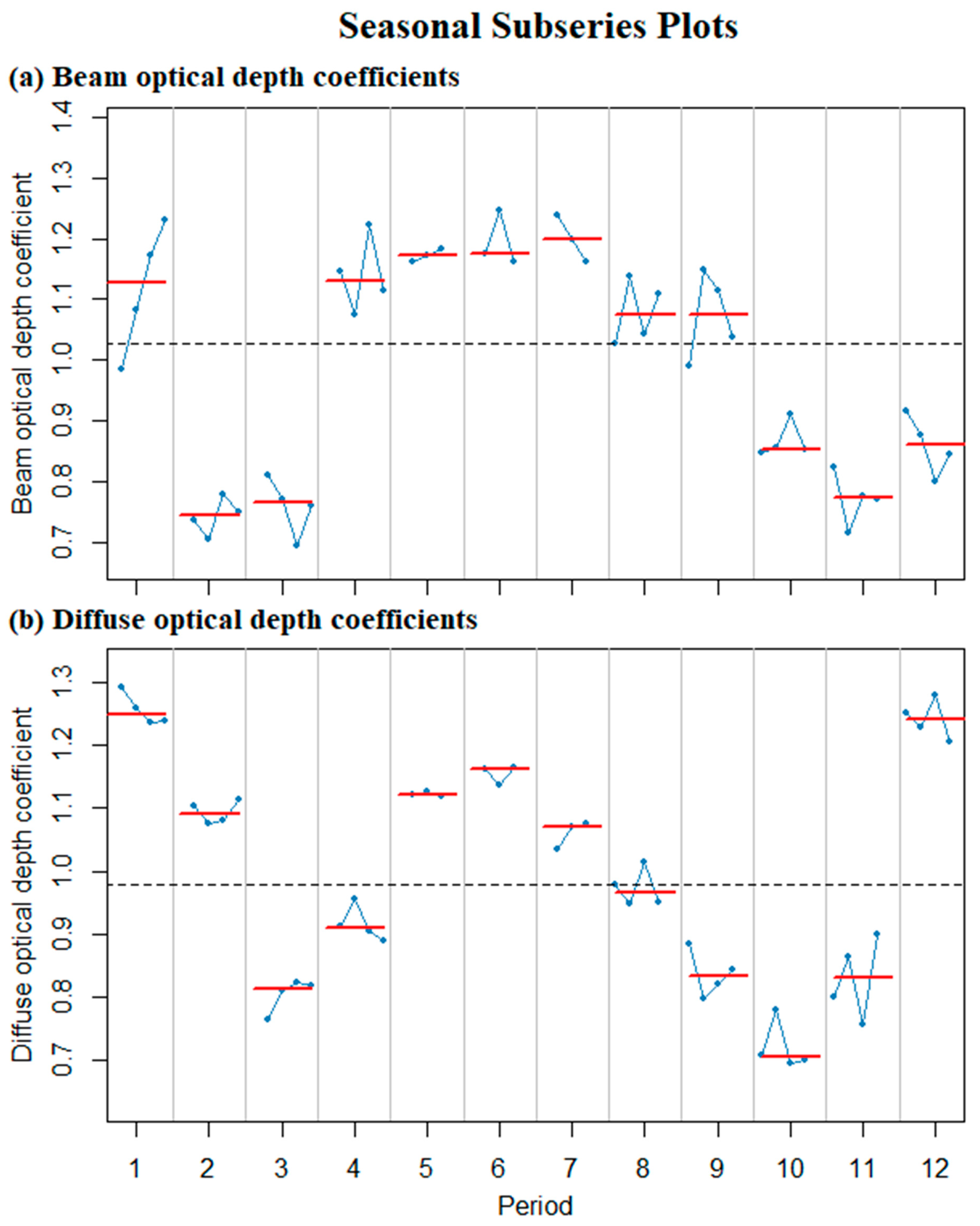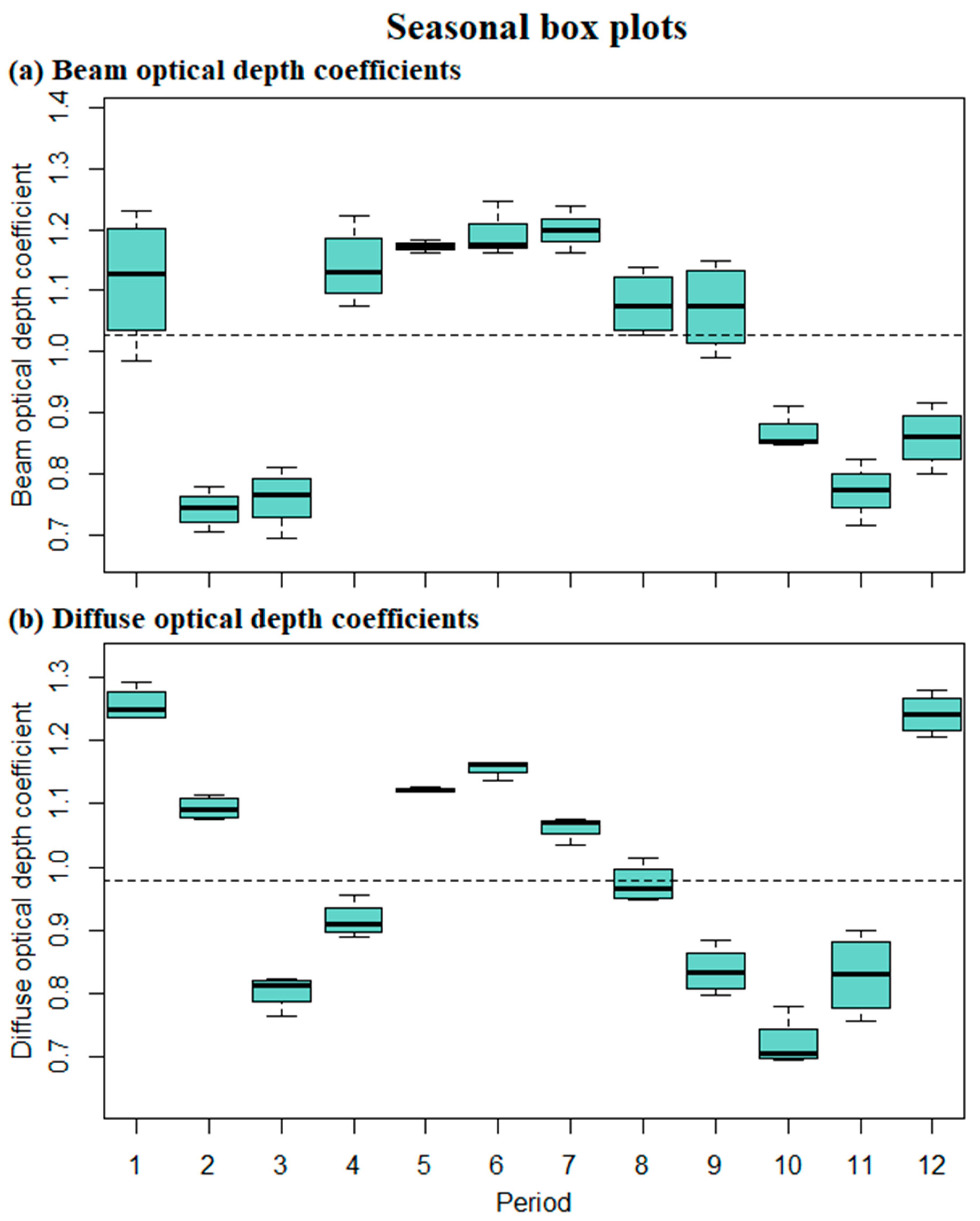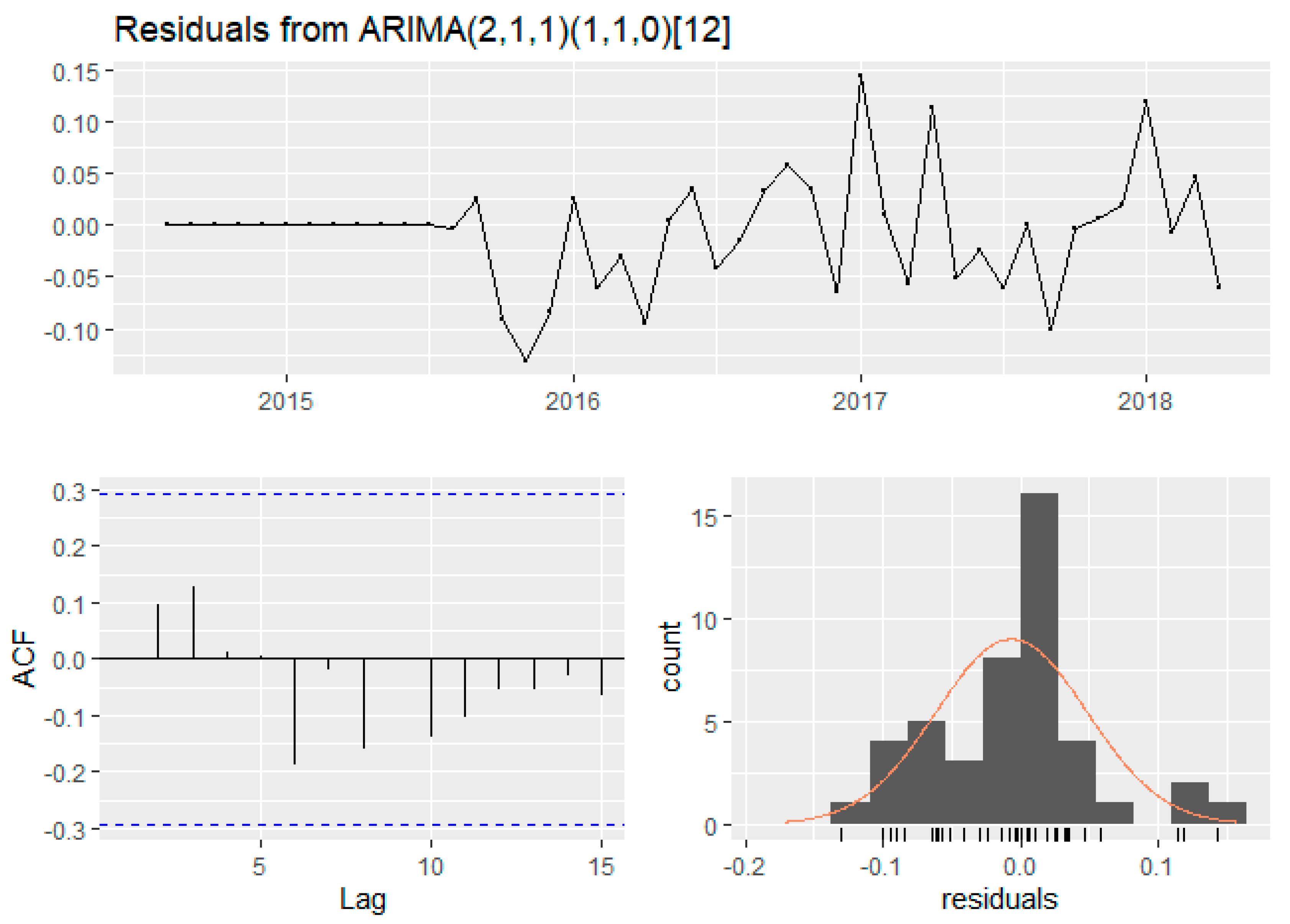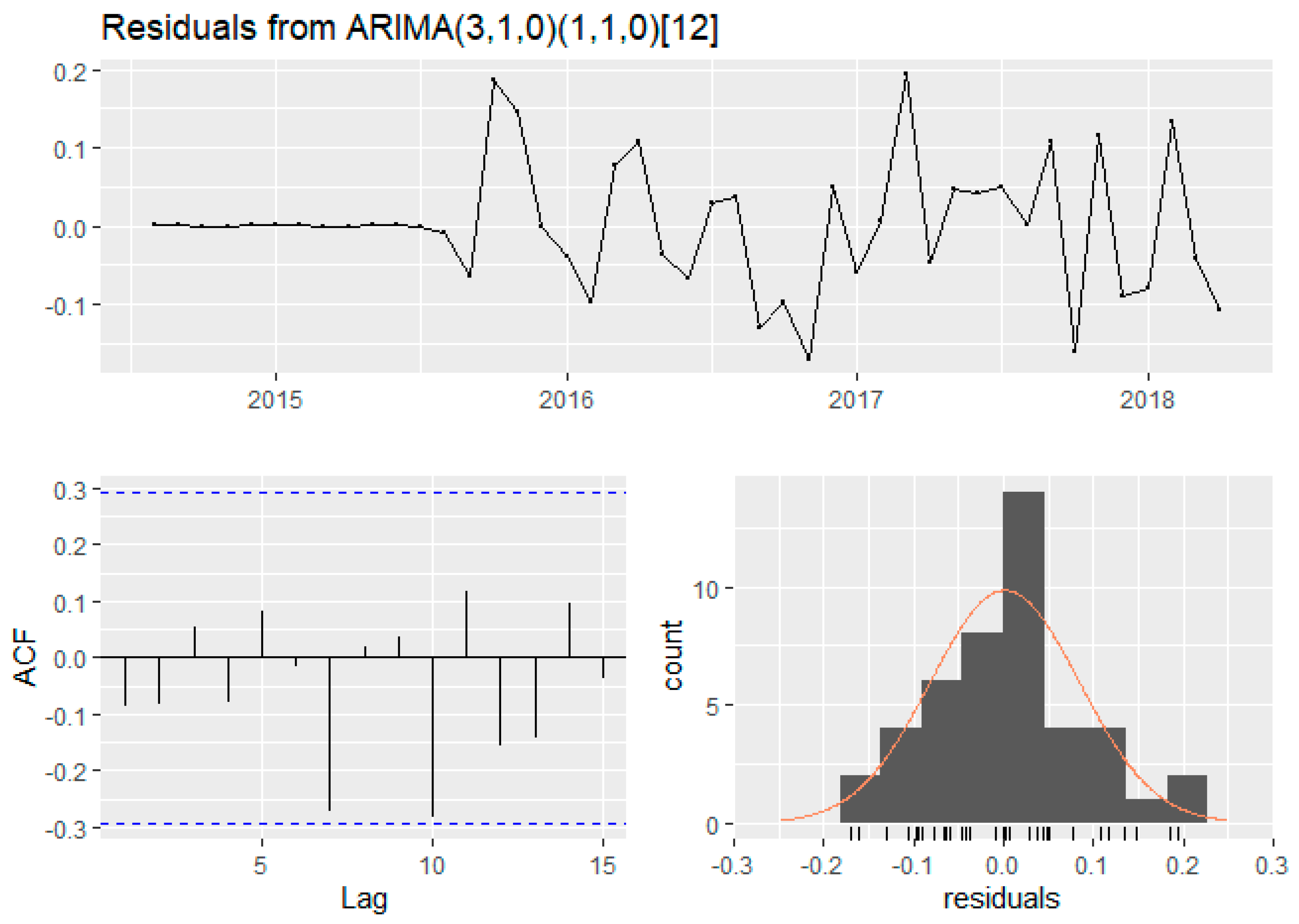The Development of ARIMA Models for the Clear Sky Beam and Diffuse Optical Depths for HVAC Systems Design Using RTSM: A Case Study of the Umlazi Township Area, South Africa
Abstract
:1. Introduction
2. Materials and Methods
3. Results and Discussion
4. Application Example
5. Conclusions
Author Contributions
Funding
Data Availability Statement
Acknowledgments
Conflicts of Interest
References
- Liang, C.; Li, X.; Melikov, A.K.; Shao, X.L.; Li, B. A quantitative relationship between heat gain and local cooling load in a general non-uniform indoor environment. Energy 2019, 182, 412–423. [Google Scholar] [CrossRef]
- Chenari, B.; Carrilho, J.D.; da Silva, M.G. Towards sustainable, energy-efficient and healthy ventilation strategies in buildings: A review. Renew. Sustain. Energy Rev. 2016, 59, 1426–1447. [Google Scholar] [CrossRef]
- Toparlar, Y.; Blocken, B.; Maiheu, B. Impact of urban microclimate on summertime building cooling demand: A parametric analysis for Antwerp, Belgium. Appl. Energy 2018, 228, 852–872. [Google Scholar] [CrossRef]
- Ürge-Vorsatz, D.; Cabeza, L.F.; Serrano, S.; Barreneche, C.; Petrichenko, K. Heating and cooling energy trends and drivers in buildings. Renew. Sustain. Energy Rev. 2015, 41, 85–98. [Google Scholar] [CrossRef] [Green Version]
- Vakiloroaya, V.; Samali, B.; Fakhar, A. A review of different strategies for HVAC energy saving. Energy Convers. Manag. 2014, 77, 738–754. [Google Scholar] [CrossRef]
- Kabanshi, A.; Ameen, A.; Hayati, A. Cooling energy simulation and analysis of an intermittent ventilation strategy under different climates. Energy 2018, 156, 84–94. [Google Scholar] [CrossRef] [Green Version]
- Jing, R.; Wang, M.; Zhang, R.; Li, N.; Zhao, Y. A study on energy performance of 30 commercial office buildings in Hong Kong. Energy Build. 2017, 144, 117–128. [Google Scholar] [CrossRef]
- Yan, D.; Zhe, T.; Yong, W.; Zhu, N. Achievements and suggestions of heat metering and energy efficiency retrofit for existing residential buildings in northern heating regions of China. Energy Policy 2011, 39, 4675–4682. [Google Scholar] [CrossRef]
- Zhou, X.; Yan, D.; Hong, T.; Ren, X. Data analysis and stochastic modelling of lighting energy use in large office buildings in China. Energy Build. 2015, 86, 275–287. [Google Scholar] [CrossRef] [Green Version]
- Energy Technology Perspectives 2016; International Energy Agency (IEA): Paris, France, 2016; Available online: https://www.iea.org/reports/cooling (accessed on 28 February 2022).
- Kapetanakis, D.S.; Mangina, E.; Finn, D.P. Input variable selection for thermal load predictive models of commercial buildings. Energy Build. 2017, 137, 13–26. [Google Scholar] [CrossRef]
- Li, X.W.; Wen, J. Review of building energy modeling for control and operation. Renew. Sustain. Energy Rev. 2014, 37, 517–537. [Google Scholar] [CrossRef]
- Pérez-Lombard, L.; Ortiz, J.; Pout, C. A review on buildings energy consumption information. Energy Build. 2008, 40, 394–398. [Google Scholar] [CrossRef]
- Niu, J.; Tian, Z.; Lu, Y.; Zhao, H.; Lan, B. A robust optimization model for designing the building cooling source under cooling load uncertainty. Appl. Energy 2019, 241, 390–403. [Google Scholar] [CrossRef]
- Xiang-Li, L.; Zhi-Yong, R.; Lin, D. An investigation on life-cycle energy consumption and carbon emissions of building space heating and cooling systems. Renew. Energy 2015, 84, 124–129. [Google Scholar] [CrossRef]
- Macas, M.; Moretti, F.; Fonti, A.; Giantomassi, A.; Comodi, G.; Annunziato, M.; Pizzuti, S.; Capra, A. The role of data sample size and dimensionality in neural network based forecasting of building heating related variables. Energy Build. 2016, 111, 299–310. [Google Scholar] [CrossRef]
- Zainal, O.A.; Yumrutas, R. Validation of periodic solution for computing CLTD (cooling load temperature difference) values for building walls and flat roofs. Energy 2015, 82, 758–768. [Google Scholar] [CrossRef]
- Sarwar, R.; Cho, H.; Cox, S.J.; Mago, P.J.; Luck, R. Field validation study of a time and temperature indexed autoregressive with exogenous (ARX) model for building thermal load prediction. Energy 2017, 119, 483–496. [Google Scholar] [CrossRef]
- Ding, Y.; Zhang, Q.; Yuan, T. Research on short-term and ultra-short-term cooling load prediction models for office buildings. Energy Build. 2017, 154, 254–267. [Google Scholar] [CrossRef]
- Li, X.; Liu, K.; Tian, J. Variability, predictability, and uncertainty in global aerosols inferred from gap-filled satellite observations and an econometric modeling approach. Remote Sens. Environ. 2021, 261, 112501. [Google Scholar] [CrossRef]
- Yu, F.; Yue, Q.; Yunianta, A.; Aljahdali, H.M.A. A novel hybrid deep correction approach for electrical load demand prediction. Sustain. Cities Soc. 2021, 74, 103161. [Google Scholar] [CrossRef]
- Dubey, A.K.; Kumar, A.; García-Díaz, V.; Sharma, A.; Kanhaiya, K.S.S. Study and analysis of SARIMA and LSTM in forecasting time series data. Sustain. Energy Technol. Assess. 2021, 47, 101474. [Google Scholar]
- Lee, D.-S.; Jo, J.-H.; Koo, S.-H.; Lee, B. Development of Climate Indices Using Local Weather Data for Shading Design. Sustainability 2015, 7, 1884–1899. [Google Scholar] [CrossRef] [Green Version]
- Jannat, N.; Hussien, A.; Abdullah, B.M.; Cotgrave, A.J. A Comparative Simulation Study of the Thermal Performances of the Building Envelope Wall Materials in the Tropics. Sustainability 2020, 12, 4892. [Google Scholar] [CrossRef]
- Gou, S.; Nik, V.M.; Scartezzini, J.-L.; Zhao, Q.; Li, Z. Passive design optimization of newly-built residential buildings in Shanghai for improving indoor thermal comfort while reducing building energy demand. Energy Build. 2018, 169, 484–506. [Google Scholar] [CrossRef]
- Konstantinou, T.; Ignjatović, Ć.N.; Zbašnik-Senegačnik, M. Energy: Resources and Building Performance; TU Delft Open: Delft, The Netherlands, 2018. [Google Scholar]
- Badea, N. Design for Micro-Combined Cooling, Heating and Power Systems. In Stirling Engines and Renewable Power Systems, 1st ed.; Springer: London, UK, 2015. [Google Scholar]
- Mao, C.; Baltazar, J.-C.; Haberl, J.S. Literature review of building peak cooling load methods in the United States. Sci. Technol. Built Environ. 2018, 24, 228–237. [Google Scholar] [CrossRef]
- Lv, L.; Huang, C.; Li, L.; Chen, J. Experimental study on calculation method of the radiant time factors. Renew. Energy 2015, 73, 28–35. [Google Scholar] [CrossRef]
- Spitler, J.D.; Fisher, D.E.; Pedersen, C.O. The radiant time series cooling load calculation procedure. ASHRAE Trans. 1997, 103, 503–515. [Google Scholar]
- Spitler, J.D.; Fisher, D.E. On the Relationship between the Radiant Time Series and Transfer Function Methods for Design Cooling Load Calculations. HVAC&R Res. 1999, 5, 123–136. [Google Scholar]
- McQuiston, F.C.; Parker, J.D.; Spitler, J.D. Heating Ventilating and Air Conditioning Analysis and Design, 6th ed.; John Wiley & Sons Inc.: San Francisco, CA, USA, 2005. [Google Scholar]
- 2017 ASHRAE Handbook—Fundamentals (SI); American Society of Heating, Refrigerating and Air-Conditioning Engineers: Atlanta, GA, USA, 2017.
- Optical Depth. Wikipedia, The Free Encyclopedia. 2020. Available online: https://en.wikipedia.org/wiki/Optical_depth (accessed on 28 February 2022).
- Kim, S.-W.; Choi, I.-J.; Yoon, S.-C. A multi-year analysis of clear-sky aerosol optical properties and direct radiative forcing at Gosan. Atmos. Res. 2010, 95, 279–287. [Google Scholar] [CrossRef]
- Tang, W.; Yang, K.; Qin, J.; Niu, X.; Lin, C.; Jing, X. A revisit to decadal change of aerosol optical depth and its impacts on global radiation over China. Atmos. Environ. 2017, 150, 106–115. [Google Scholar] [CrossRef]
- Kudish, A.I.; Evseev, E.G. UVB irradiance and atmospheric optical depth at the Dead Sea basin, Israel: Measurements and modeling. Renew. Energy 2012, 48, 344–349. [Google Scholar] [CrossRef]
- Serrano, M.A.; Boscà, J.V.; Cañada, J. The determination of a band factor to express irradiance of UV and PAR wavelength ranges in a clean and dry atmosphere at Valencia, Spain. Int. J. Ambient Energy 2008, 29, 171–180. [Google Scholar] [CrossRef]
- Kasten, F.; Young, A.T. Revised optical air mass tables and approximation formula. Appl. Opt. 1989, 28, 4735–4738. [Google Scholar] [CrossRef] [PubMed]
- Iqbal, M. An Introduction To Solar Radiation; Academic Press: Toronto, ON, Canada, 1983. [Google Scholar]
- Elsaraiti, M.; Merabet, A. A Comparative Analysis of the ARIMA and LSTM Predictive Models and Their Effectiveness for Predicting Wind Speed. Energies 2021, 14, 6782. [Google Scholar] [CrossRef]
- Bento, P.M.R.; Pombo, J.Á.N.; Calado, M.d.R.; Mariano, S.J.P.S. Stacking Ensemble Methodology Using Deep Learning and ARIMA Models for Short-Term Load Forecasting. Energies 2021, 14, 7378. [Google Scholar] [CrossRef]
- Liu, X.; Lin, Z.; Feng, Z. Short-term offshore wind speed forecast by seasonal ARIMA—A comparison against GRU and LSTM. Energy 2021, 227, 120492. [Google Scholar] [CrossRef]
- Bashir, T.; Haoyong, C.; Tahir, M.F.; Liqiang, Z. Short term electricity load forecasting using hybrid prophet-LSTM model optimized by BPNN. Energy Rep. 2022, 8, 1678–1686. [Google Scholar] [CrossRef]
- Hassan, J. ARIMA and regression models for prediction of daily and monthly clearness index. Renew. Energy 2014, 68, 421–427. [Google Scholar] [CrossRef]
- Ghoneim, A.A.; Kadad, I.M.; Altouq, M.S. Statistical analysis of solar UVB and global radiation in Kuwait. Energy 2013, 60, 23–34. [Google Scholar] [CrossRef]
- Mutombo, N.M.-A.; Mukuna, J.G.M.; Zawilska, E. Preliminary Analysis of Ground-Based Measured Solar Data from Sauran STA Station at Umlazi, South Africa. Int. J. Mech. Eng. Technol. 2019, 10, 104–113. [Google Scholar]
- Huang, J.; Korolkiewicz, M.; Agrawal, M.; Boland, J. Forecasting solar radiation on an hourly time scale using a Coupled Auto Regressive and Dynamical System (CARDS) model. Solar Energy 2013, 87, 136–149. [Google Scholar] [CrossRef]
- Hassan, A.; Hejase, N.; Assi, A.H. Time-series regression model for prediction of mean daily global solar radiation in Al-Ain, UAE. Int. Sch. Res. Not. 2012, 2012, 1–11. [Google Scholar]
- Sulaiman, M.Y.; Oo, W.M.H.; Wahab, M.A.B.D.; Sulaiman, Z.A. Analysis of residuals in daily solar radiation time series. Renew. Energy 1997, 11, 97–105. [Google Scholar] [CrossRef] [Green Version]
- Zaharim, A.; Razali, A.M.; Gim, T.P.; Sopian, K. Time series analysis of solar radiation data in the tropics. Eur. J. Sci. Res. 2009, 25, 672–678. [Google Scholar]







| Statistic Parameters | Beam Optical Depth | Diffuse Optical Depth | ||||
|---|---|---|---|---|---|---|
| Naive Method | ETS Model | ARIMA Model | Naive Method | ETS Model | ARIMA Model | |
| Q | 9.6967 | 14.684 | 4.7057 | 12.665 | 28.608 | 5.7502 |
| df | 9 | 3 | 5 | 9 | 3 | 5 |
| p-value | 0.3756 | 0.0021 | 0.4528 | 0.1784 | 2.7 × 10−6 | 0.3313 |
| Model df | 0 | 14 | 4 | 0 | 14 | 4 |
| Total lags used | 9 | 17 | 9 | 9 | 17 | 9 |
| Test | Beam Optical Depth | Diffuse Optical Depth | ||||
|---|---|---|---|---|---|---|
| Naive Model | ETS Model | ARIMA Model | Naive Method | ETS | ARIMA Model | |
| MPE | 106.40 | 0.2611 | −1.1330 | −54.724 | −0.1012 | −0.0026 |
| MAE | 0.0843 | 0.0383 | 0.0368 | 0.1433 | 0.0605 | 0.0586 |
| MAPE | 166.72 | 4.2783 | 4.1807 | 108.62 | 2.7253 | 2.7009 |
| RMSE | 0.0981 | 0.0490 | 0.0547 | 0.1859 | 0.0757 | 0.0819 |
| MASE | 1 | 0.6155 | 0.5913 | 1 | 0.5726 | 0.5551 |
| Component | Area (m2) | Material | Surface Azimuth [0] | Surf. Tilt from Horiz. [0] |
|---|---|---|---|---|
| Roof | 14.00 | New sheet metal galvanized roof surface. | −45 | 0 |
| Wall | 4.00 | White acrylic paint surface wall. | −45 | 90 |
| Window | 6.00 | Single glazing-type 5d6 window system. | −45 | 90 |
| Local Std. Hour (Hrs) | Wall and Window Solar Irradiance (W) | Roof Solar Irradiance (W) | Wall Cooling Load (W) | Window Cooling Load (W) | Roof Cooling Load (W) | Total Cooling Load (W) |
|---|---|---|---|---|---|---|
| 0 | 0 | 0 | 6.8894 | 81.8090 | 11.9367 | 100.6351 |
| 1 | 0 | 0 | 5.9455 | 64.7724 | 10.5787 | 81.2966 |
| 2 | 0 | 0 | 5.0594 | 48.2553 | 9.3571 | 62.6718 |
| 3 | 0 | 0 | 4.2717 | 35.7263 | 8.4919 | 48.4900 |
| 4 | 0 | 0 | 3.6275 | 28.2710 | 7.8926 | 39.7911 |
| 5 | 102.6300 | 44.0217 | 3.1146 | 194.0213 | 7.3696 | 204.5055 |
| 6 | 353.8490 | 160.6268 | 2.9747 | 816.7486 | 8.7377 | 828.4611 |
| 7 | 412.0918 | 319.5139 | 3.8572 | 1105.1196 | 14.8966 | 1123.8734 |
| 8 | 370.0991 | 478.6413 | 5.9839 | 1041.6774 | 28.1285 | 1075.7898 |
| 9 | 270.4189 | 613.8186 | 8.6754 | 731.4266 | 46.2352 | 786.3372 |
| 10 | 140.5037 | 708.6097 | 11.1200 | 442.3355 | 65.8183 | 519.2739 |
| 11 | 298.5987 | 755.0025 | 12.8998 | 596.4177 | 83.7919 | 693.1094 |
| 12 | 116.6168 | 741.0646 | 14.3917 | 370.7617 | 97.0910 | 482.2444 |
| 13 | 106.8468 | 675.2933 | 15.5691 | 300.0449 | 104.5589 | 420.1729 |
| 14 | 93.1774 | 562.2877 | 16.0585 | 259.4217 | 105.5651 | 381.0453 |
| 15 | 75.9243 | 414.8976 | 16.2188 | 235.6355 | 100.6220 | 352.4763 |
| 16 | 56.0850 | 252.3353 | 16.2377 | 206.5021 | 89.9904 | 312.7303 |
| 17 | 35.0694 | 103.9000 | 15.9242 | 173.3563 | 74.1284 | 263.4089 |
| 18 | 19.9962 | 39.7395 | 15.1109 | 146.9955 | 55.7983 | 217.9047 |
| 19 | 0 | 0 | 13.8759 | 118.2320 | 39.7908 | 171.8987 |
| 20 | 0 | 0 | 12.3557 | 103.6728 | 27.8380 | 143.8666 |
| 21 | 0 | 0 | 10.7259 | 95.8722 | 20.1479 | 126.7460 |
| 22 | 0 | 0 | 9.2052 | 92.1492 | 15.8262 | 117.1807 |
| 23 | 0 | 0 | 7.9439 | 87.5994 | 13.5509 | 109.0942 |
Publisher’s Note: MDPI stays neutral with regard to jurisdictional claims in published maps and institutional affiliations. |
© 2022 by the authors. Licensee MDPI, Basel, Switzerland. This article is an open access article distributed under the terms and conditions of the Creative Commons Attribution (CC BY) license (https://creativecommons.org/licenses/by/4.0/).
Share and Cite
Mutombo, N.M.-A.; Numbi, B.P. The Development of ARIMA Models for the Clear Sky Beam and Diffuse Optical Depths for HVAC Systems Design Using RTSM: A Case Study of the Umlazi Township Area, South Africa. Sustainability 2022, 14, 3662. https://doi.org/10.3390/su14063662
Mutombo NM-A, Numbi BP. The Development of ARIMA Models for the Clear Sky Beam and Diffuse Optical Depths for HVAC Systems Design Using RTSM: A Case Study of the Umlazi Township Area, South Africa. Sustainability. 2022; 14(6):3662. https://doi.org/10.3390/su14063662
Chicago/Turabian StyleMutombo, Ntumba Marc-Alain, and Bubele Papy Numbi. 2022. "The Development of ARIMA Models for the Clear Sky Beam and Diffuse Optical Depths for HVAC Systems Design Using RTSM: A Case Study of the Umlazi Township Area, South Africa" Sustainability 14, no. 6: 3662. https://doi.org/10.3390/su14063662
APA StyleMutombo, N. M.-A., & Numbi, B. P. (2022). The Development of ARIMA Models for the Clear Sky Beam and Diffuse Optical Depths for HVAC Systems Design Using RTSM: A Case Study of the Umlazi Township Area, South Africa. Sustainability, 14(6), 3662. https://doi.org/10.3390/su14063662





